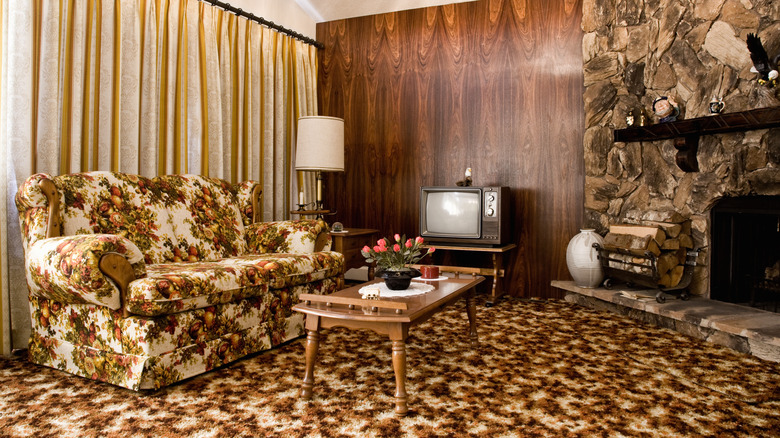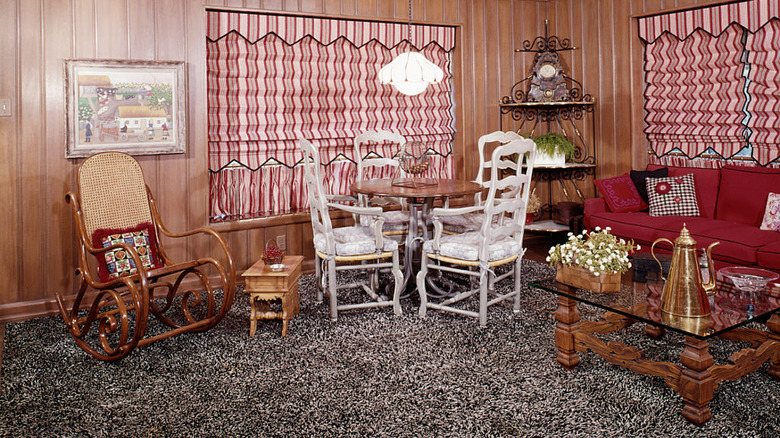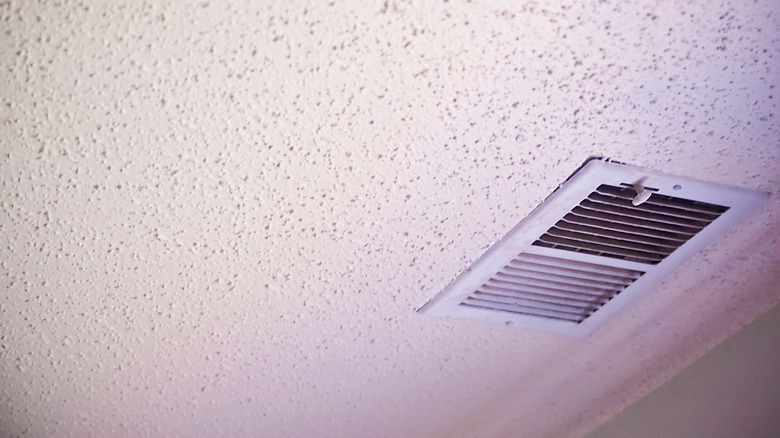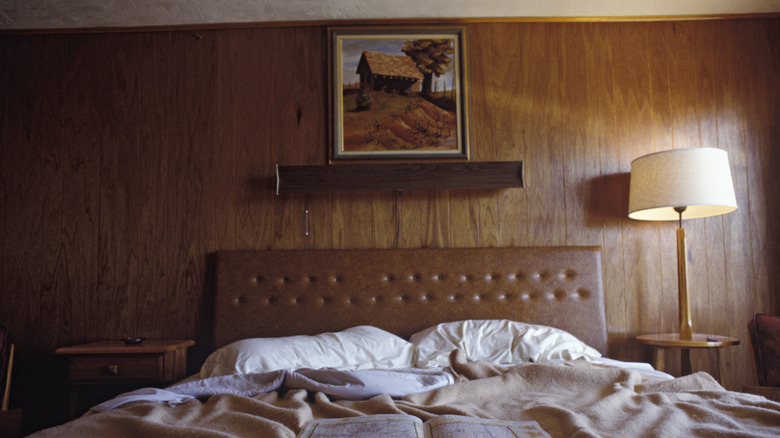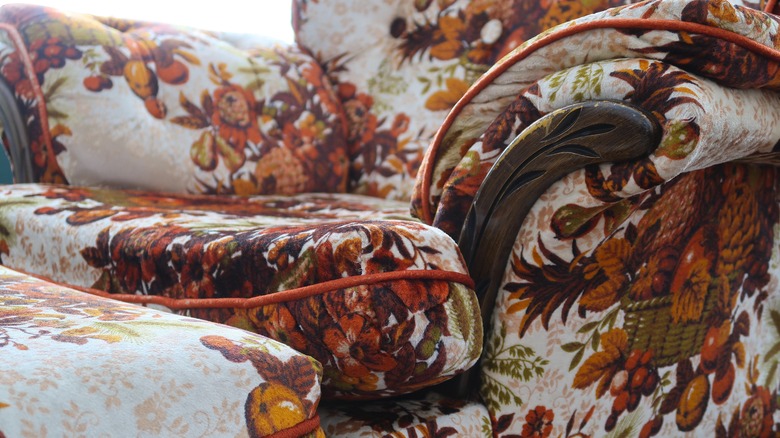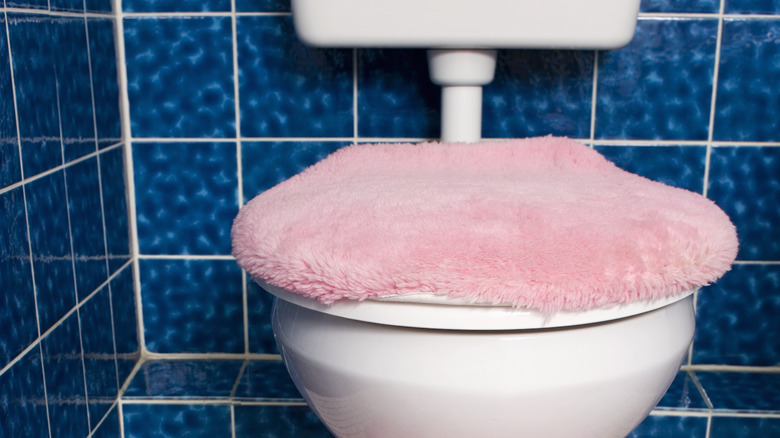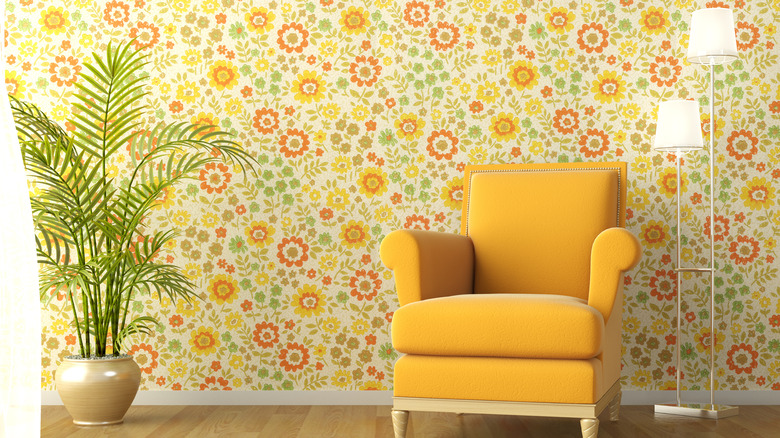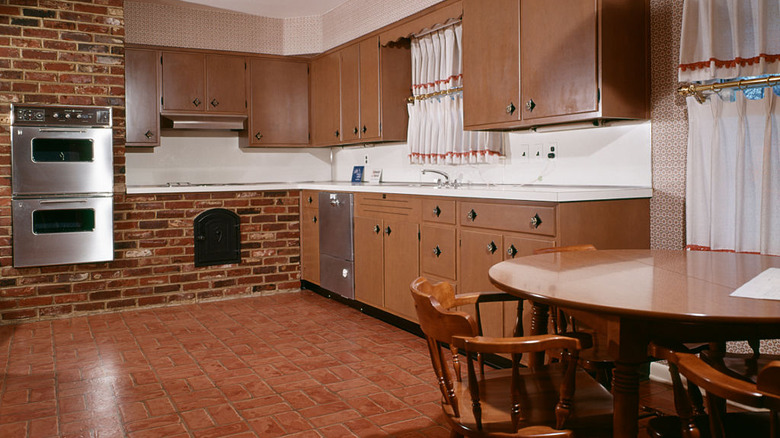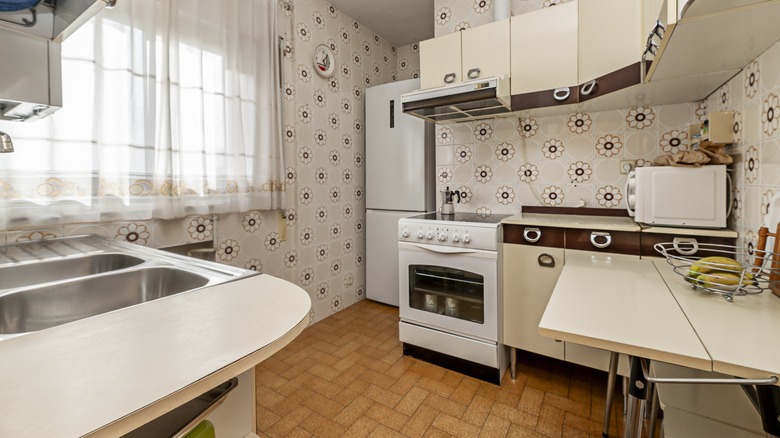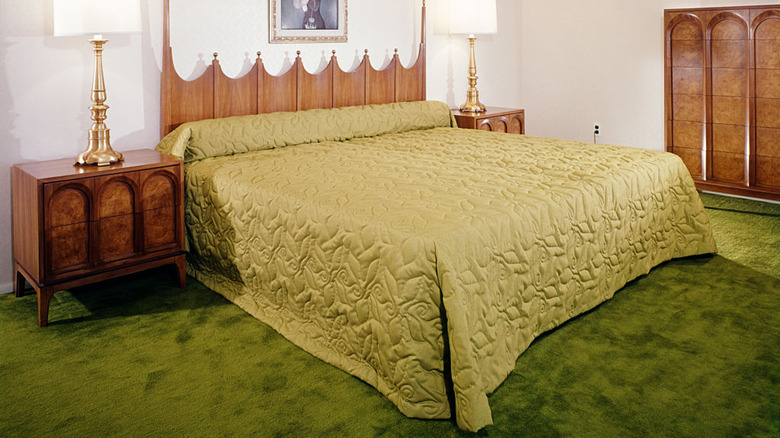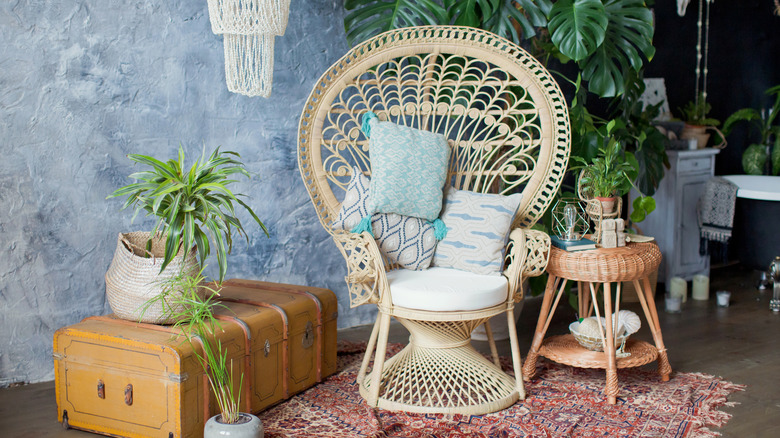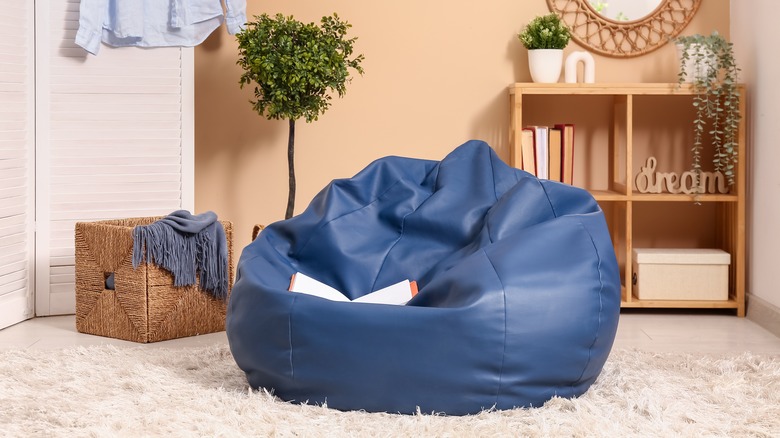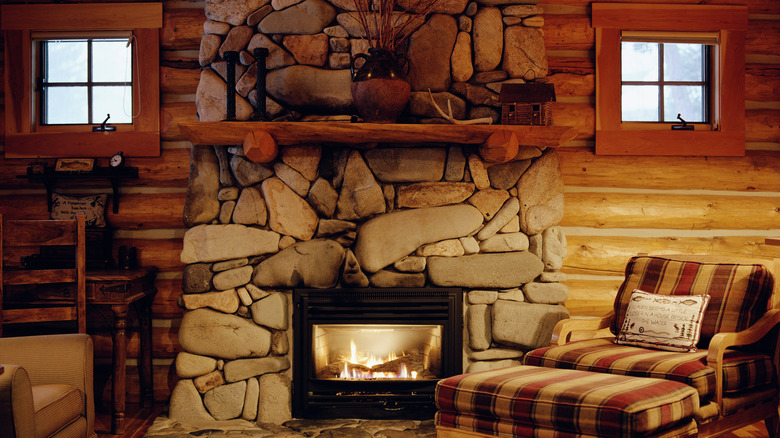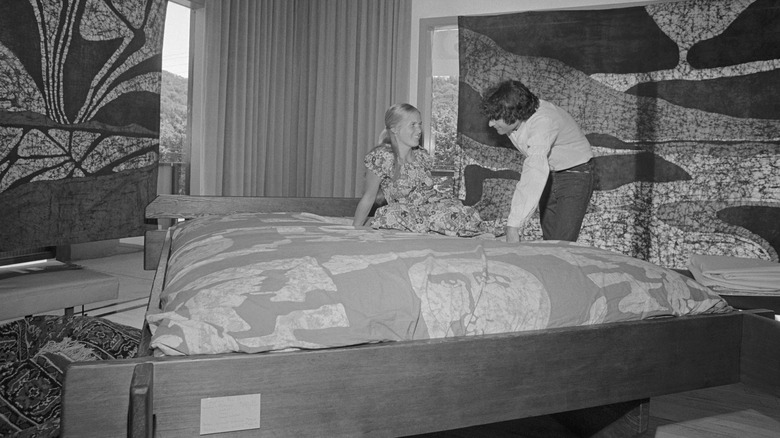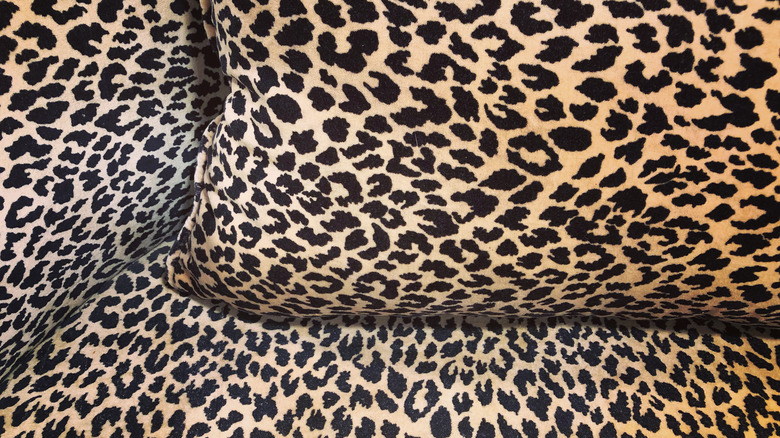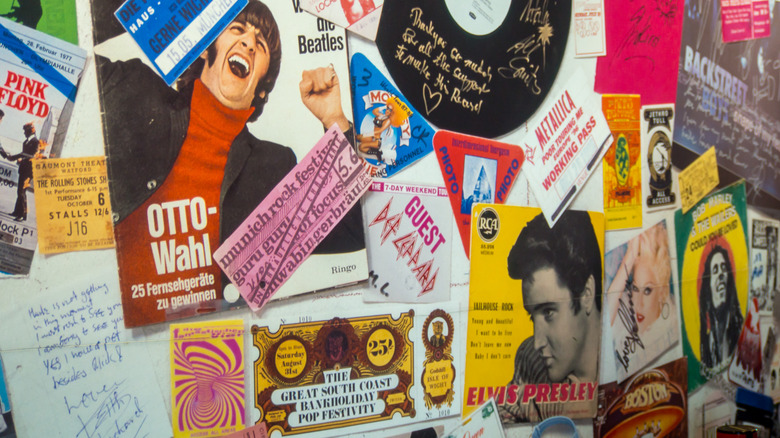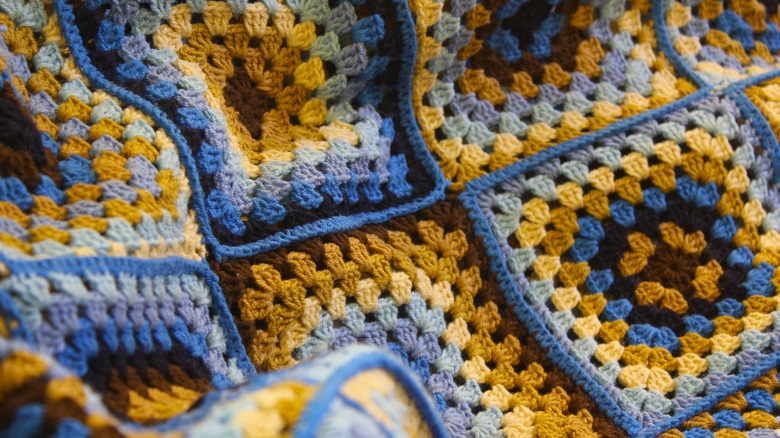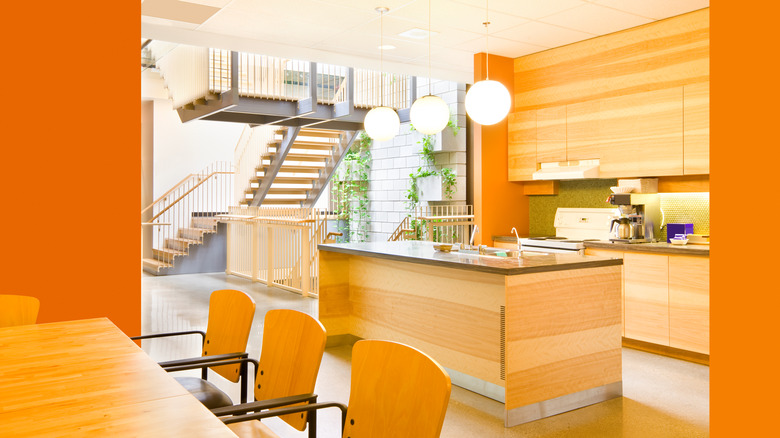17 Popular Design Trends From 50 Years Ago That Should Stay In The Past
Incorporating retro décor into your space is a great way to add some variety to your home and curate an eclectic, timeless look. Vintage pieces are often well-made, well-priced, and well-loved, but unfortunately, people in the past didn't always hit the nail on the head with their designs. As time rolls on, it's easy to romanticize the design choices of former decades and pick and choose which items fall in line with a more modern tastes, but it can also be fun to take a look back on the pieces that we'd rather forget — like shag carpets, patterned furniture, and bold color choices.
Five decades ago, the 1970s were in full swing. It was an era of natural aesthetics, bold self-expression, and rich texture in everything from clothing to home décor. These characteristic qualities are something that are still valued in design today, and they can bring a ton of interest to an otherwise bland, stark, or flat space. As with any era that tended to veer into extremes, however, it was definitely possible to take it too far. Let's take a look back at some of the trends of the '70s that most would agree should stay there, memorialized in family photos and never to return to our spaces.
1. Shag carpeting
Back in the '70s, no room was complete without a massive amount of high-pile shag carpeting. While this textured surface certainly made a room feel cozier, it was also an incredibly bold choice for all-over flooring. Shag carpeting is notoriously difficult to clean and maintain, so even with near-constant vacuuming and an abundance of caution avoiding stains, it's destined to look a bit worn and dingy. Pair the whole look with the warm, saturated colors that were popular during the decade, and you have a design that's visually overwhelming even before you add in furniture and décor.
2. Popcorn ceilings
Design trends of the '70s consistently favored texture. This is fantastic in theory, but unfortunately, it often came at the cost of functionality. Popcorn ceilings are no exception. This bumpy material was often used as a way to dampen noise and cover imperfections on a budget, but it also acted as a difficult to clean collection point for dust and cobwebs. In many older homes, this texture was created using sprayed-on asbestos, so it's no wonder why so many people are looking for ways to easily remove popcorn ceilings in their spaces, both for aesthetic and health reasons.
3. Wood paneling
Wood paneling is a controversial design choice, to say the least. In many spaces, it can add a much-needed dose of warmth and texture. In others, it can make you feel like you're trapped in a dingy basement. Wood paneling was a massive trend in the '70s, so it often found its way into rooms that didn't necessarily need it. Floor-to-ceiling paneling, especially if it's made of a cheaper wood or treated with a bright stain, can be a lot to take in visually and can limit your furniture and décor options.
4. Patterned furniture
Nowadays, it's common to limit the patterns we bring into our homes to throw pillows or wall art. In the '70s, however, bold prints found their way onto just about everything. While a heavily patterned chair or sofa could be a fantastic focal point in a living room when coupled with simpler accents, it was more likely that this was just one of many pieces competing for attention. Harvest-toned florals, chunky plaid, and graphic stripes often competed with similarly-colored prints on the walls and floor to create a look that could overwhelm even the bravest maximalist.
5. Plush toilet lid covers
There are plenty of bathroom décor trends that should be left in the past, but one of the most hated examples is the plush toilet lid cover. Carpeting in a bathroom — with the exception of one or two easy to clean rugs — is never a good idea, and placing something plush right over your toilet is a recipe for mold and bacteria, especially if it's right next to the shower or your bathroom is small. Thankfully, this trend has fallen out of popularity over the years in favor of more sanitary design choices.
6. Bold wallpaper
Contrary to popular belief, wallpaper isn't always a design faux pas. If you take the time and effort to choose the right wallpaper for your space, it can seriously transform a room without much effort. If you don't, however, it can be a design disaster. You've likely learned by now that '70s design trends didn't shy away from pattern, so it wasn't uncommon to completely cover a room in a busy, overwhelming print. While there's no reason to disavow wallpaper completely, most can agree that we should leave the chaotic prints of this decade in the past.
7. Patterned linoleum flooring
Linoleum flooring is a lower-cost alternative to many of the other options on the market like tile and hardwood. Unfortunately, however, this reduced price often showed in the final look. Many of the popular patterns were bright, bold, and gaudy, but even the simpler choices feel more like something that should line a school hallway and not complete your kitchen. There's also, of course, the asbestos problem. If you're looking to rip up your outdated flooring, make sure you wear a mask and send some samples off for testing before going all-in on the demo.
8. Laminate countertops
Laminate countertops were a popular option in the '70s thanks to their low price tag and large variety of available colors. While this material is generally somewhat durable to normal wear and tear, it can face some major issues with scratches, staining, and water damage over time. Because of this, it's likely that those laminate countertops installed in the '70s were looking worse for wear by the time the '80s rolled around. If you ask us, it's best to look into a different affordable countertop material if you're planning a kitchen upgrade on a budget.
9. Avocado green
There's nothing wrong with incorporating green into your interiors — in fact, neutral green paint colors are very popular — but it's certainly possible to take it too far. Popular colors in the '70s were very warm and autumnal, with rich avocado green absolutely dominating the trends at the time. While a small dose of this color can be lovely, completely coating a room in it can start to make things feel a bit sickly. Instead, try out a shade with a more muted base or break up the color with neutral accents for some balance.
10. Peacock chairs
Wicker furniture was all the rage during the '70s and is experiencing quite the comeback today. There is, however, one item that's probably best to leave in the past. Peacock chairs feature a relatively small seat with a massive backing that often resembles — you guessed it — peacock feathers. While these chairs can make a major statement in a sunroom or on your patio, they're notoriously uncomfortable for lounging. If you're looking for something to use in a photo op, this is a great choice, but if you actually want something functional, there are plenty of better options available.
11. Bean bag chairs
Plopping down onto a cozy bean bag chair after a long day might sound cozy, but once it's time to stand up, you'll likely see the downside of this relaxed seating arrangement that took the world by storm in the '70s. While they're the perfect item to bring into a cramped dorm room or children's playroom, it's safe to say that a bean bag isn't the classiest furniture option to incorporate into your primary living space. Instead, opt for something slightly more structured with the same plush feel, like an overstuffed armchair or extra deep loveseat.
12. Stone facade fireplaces
A fireplace can act as a gorgeous focal point in a living room, but the '70s brought an interesting spin on more traditional brick options. Falling in line with the other nature-focused trends of the decade, many opted for an organic-looking stone fireplace. When done intentionally with high-quality materials, these fireplaces can bring a cozy, cabin-like feel to a room. When the hearth is covered in haphazardly-placed manufactured stones, however, you're more likely to be left with an outdated-looking eyesore. When you're making such a long lasting design choice, it's usually best to stick to classic materials.
13. Waterbeds
While waterbeds likely seemed like a new and innovative idea at the time, the novelty quickly wore off once people actually began buying and using these mattresses. Hindsight, of course, is 20/20, and it's safe to assume that by now, most agree that sleeping on what's essentially a giant water balloon every night isn't the best idea. If you're still on the hunt for a mattress that promises to keep you cool and comfortably conform to your body, try out memory foam — almost all the same benefits without the looming threat of a small leak flooding your entire bedroom.
14. Animal print
Lions, tigers, and bears. Oh my! The décor of the '70s had an overarching natural theme, but that doesn't mean that it was all about houseplants and wicker. This era also saw a rise in popularity of animal prints. While these patterned fabrics (and actual animal hides, in some cases) were initially seen as glamorous, they've developed a reputation for looking cheap as the years have gone on. If you still want to incorporate some wild touches in your space, consider using these prints as small accents rather than an all-over pattern on a couch or carpet.
15. Posters galore
The trend of plastering your bedroom wall in posters of your favorite musicians and actors really took off in the '70s, and nowadays, it's still a common way for teens to decorate their space without spending a ton of money. As an adult, however, it's common to look back on the mess of papers stuck to your wall with tape and pushpins and wonder what you were thinking. To create a space that carries the same amount of personality without all the chaos, consider framing your favorite posters to add some polish and create an eclectic gallery wall.
16. Itchy granny square blankets
Crochet absolutely took over in the '70s both in home décor and clothing, but these cozy-looking items often carried some hidden discomfort. Granny square blankets are still an incredibly common project today and can provide a heaping dose of coziness and handmade flair in your space, but the blankets of the '70s were almost invariably itchy and rough. Heartfelt and handmade granny square blankets will never go out of style, but let's all agree to leave the scratchy wool blend yarns in the past in favor of something that's a bit gentler on the skin.
17. Loud color drenching
If you choose the same color for everything, you can guarantee it will match. You can also guarantee that you'll leave the room with a headache, especially if you like to stick to a brighter color palette. A lot of the trends of the '70s involved completely dunking a room head-to-toe in the same color, whether it was harvest gold, burnt orange, or avocado green. Monochrome palettes can certainly still work today, but it's important to balance things out with some neutrals to break things up and give your eyes a break from the heavy saturation.
